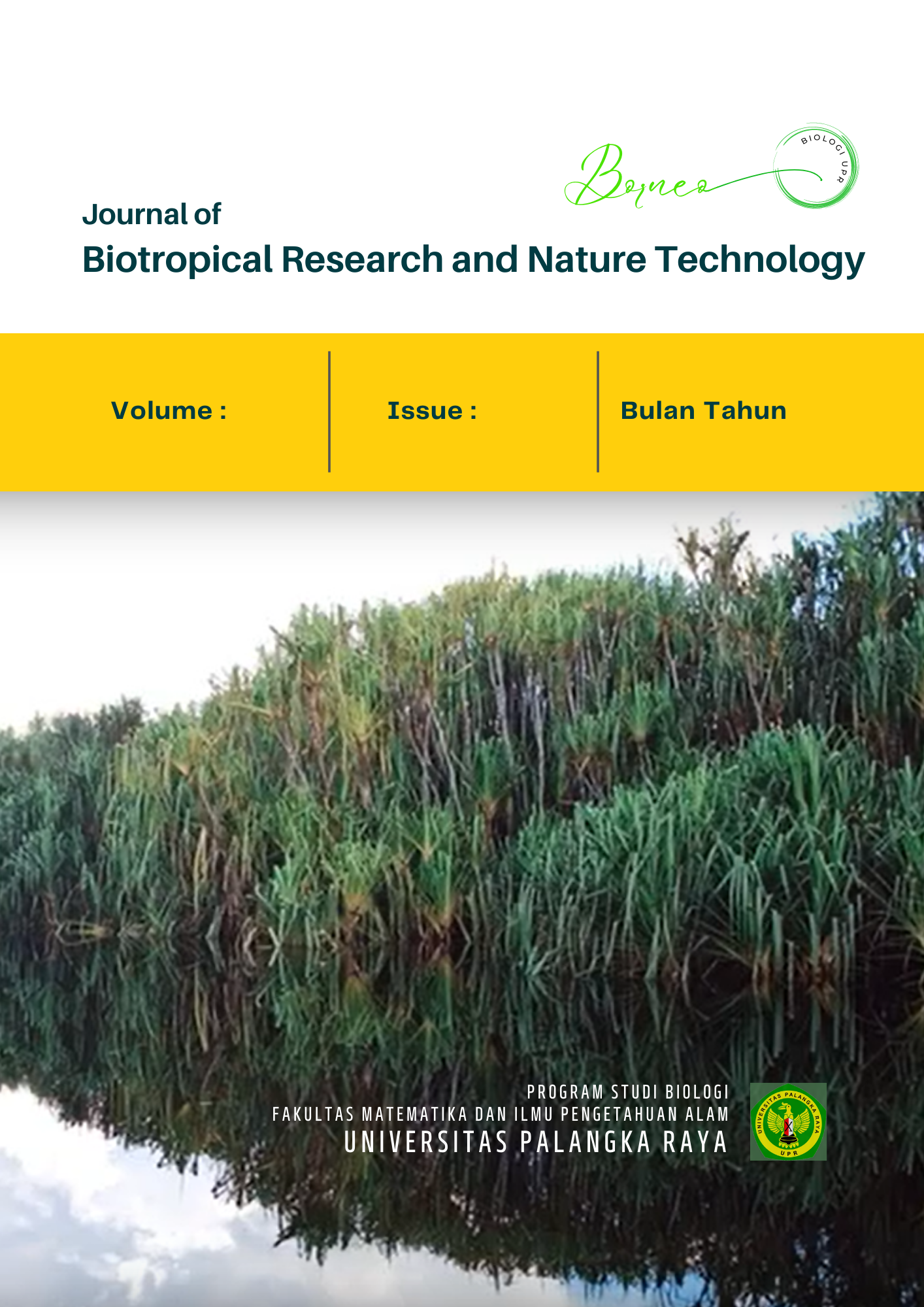Teknik Isolasi DNA dari Daging Ikan Salmon (Oncorhynchus masou) Tuna (Thunnus obesus) dan Tongkol (Euthynnus affinis) Menggunakan Metode Spin Column
DOI:
https://doi.org/10.52850/borneo.v3i2.19891Keywords:
Isolasi DNA; Salmon; Spin Colom; Tuna, TongkolAbstract
Penelitian ini bertujuan untuk mengevaluasi efektivitas metode spin column dalam isolasi DNA dari jaringan daging ikan Salmon (Oncorhynchus masou), Tuna (Thunnus obesus), dan Tongkol (Euthynnus affinis), tiga spesies bernilai ekonomi tinggi di sektor perikanan Indonesia. Isolasi DNA dilakukan menggunakan metode spin column dengan kit Tianamp, melalui tahapan lisis jaringan daging ikan, presipitasi DNA, pencucian kontaminan, dan elusi akhir, kemudian dianalisis kuantitas dan kemurniannya menggunakan spektrofotometri pada panjang gelombang 260/280 nm. Hasil menunjukkan konsentrasi DNA berkisar 50.8–183.3 ng/μL (rata-rata 109.3 ng/μL), namun kemurnian DNA (A260/A280) berada pada kisaran 1.19–1.83 (rata-rata 1.46), mengindikasikan kontaminasi protein/RNA. Ikan Salmon menunjukkan kemurnian tertinggi (1.83), sedangkan Tongkol memiliki konsentrasi tertinggi (183.3 ng/μL) tetapi kemurnian terendah (1.19). Diduga faktor pemanasan dan inhibitor sebagai penyebab rendahnya kemurnian DNA pada penelitian ini. Rekomendasi optimasi meliputi modifikasi suhu inkubasi, penggunaan fenol-kloroform, dan pengelolaan pasca-panen. Penelitian ini memberikan kontribusi dalam pengembangan teknik isolasi DNA untuk aplikasi biologi molekuler dan industri perikanan.
Downloads
References
K. Böhme, P. Calo-Mata, J. Barros-Velázquez, and I. Ortea, “Review of Recent DNA-Based Methods for Main Food-Authentication Topics,” J. Agric. Food Chem., vol. 67, no. 14, pp. 3854–3864, Mar. 2019, doi: 10.1021/acs.jafc.8b07016.
Q. Ahmed dkk., “Euthynnus affinis(little tuna): fishery, bionomics, seasonal elemental variations, health risk assessment and conservational management,” Front. Life Sci., vol. 8, no. 1, pp. 71–96, Oct. 2014, doi: 10.1080/21553769.2014.961617.
K. Marsaglia, S. Shapiro, L. Doran, and D. Tentori, IODP Technical Note. in International Ocean Discovery Program Technical Note. International Ocean Discovery Program, 2015. doi: 10.14379/iodp.tn.3.2015.
A. Supriatna, B. Hascaryo, S. H. Wisudo, and M. S. Baskoro, “Value Chain Model Development of Tuna and Tuna Alike In Indonesia,” J. Pengolah. Has. Perikan. Indones., vol. 17, no. 2, Nov. 2014, doi: 10.17844/jphpi.v17i2.8718.
S. S. Chan, B. T. Rotabakk, T. Løvdal, J. Lerfall, and B. Roth, “Skin and vacuum packaging of portioned Atlantic salmon originating from refrigerated seawater or traditional ice storage,” Food Packag. Shelf Life, vol. 30, p. 100767, Dec. 2021, doi: 10.1016/j.fpsl.2021.100767.
P. Angthong dkk., “Optimization of high molecular weight DNA extraction methods in shrimp for a long-read sequencing platform,” PeerJ, vol. 8, pp. e10340–e10340, Nov. 2020, doi: 10.7717/peerj.10340.
B. B. Collette, C. Reeb, and B. A. Block, “Systematics of the tunas and mackerels (Scombridae),” in Fish Physiology, vol. 19, Elsevier, 2001, pp. 1–33. doi: 10.1016/S1546-5098(01)19002-3.
A. Krasnov, G. Timmerhaus, S. Afanasyev, and S. M. Jørgensen, “Development and assessment of oligonucleotide microarrays for Atlantic salmon (Salmo salar L.),” Comp. Biochem. Physiol. Part D Genomics Proteomics, vol. 6, no. 1, pp. 31–38, Mar. 2011, doi: 10.1016/j.cbd.2010.04.006.
M. Endoh dkk., “Efficient Artificial Fertilization and Ovulated Egg Preservation in Kawakawa Euthynnus affinis,” J. Mar. Sci. Eng., vol. 10, no. 5, p. 599, Apr. 2022, doi: 10.3390/jmse10050599.
J. Wang and Y. Cheng, “Enhancing aquaculture disease resistance: Antimicrobial peptides and gene editing,” Rev. Aquac., vol. 16, no. 1, pp. 433–451, Jul. 2023, doi: 10.1111/raq.12845.
T. Chen dkk., “Detecting fish community structure in open waters using environmental DNA: a case study from the central South China Sea,” Front. Mar. Sci., vol. 12, Mar. 2025, doi: 10.3389/fmars.2025.1544827.
A. A. Setiaputri dkk., “Perbandingan Metode Isolasi DNA pada Produk Perikanan Segar dan Olahan: Comparison of DNA Isolation Methods for Fresh and Processed Seafood,” J. Pengolah. Has. Perikan. Indones., vol. 23, no. 3, pp. 447–458, Dec. 2020, doi: 10.17844/jphpi.v23i3.32314.
D. Retnaningati, “Optimasi Metode Ekstraksi DNA pada Melon (Cucumis melo L.) Berdasarkan Suhu, Lama Inkubasi, dan Kondisi Daun,” Biota J. Ilm. Ilmu-Ilmu Hayati, pp. 109–114, Jan. 2021, doi: 10.24002/biota.v5i2.4096.
M. A. Renshaw, B. P. Olds, C. L. Jerde, M. M. McVeigh, and D. M. Lodge, “The room temperature preservation of filtered environmental DNA samples and assimilation into a phenol-chloroform-isoamyl alcohol DNA extraction,” Mol. Ecol. Resour., vol. 15, no. 1, pp. 168–176, Jan. 2015, doi: 10.1111/1755-0998.12281.
Y. Sato, “DNA Extraction from Mummified Tissues,” in Molecular Analyses, 1st ed., Boca Raton: CRC Press, 2022, pp. 9–16. doi: 10.1201/9781003247432-2.
F. Liu, W. Wu, S. Chen, H. Wang, and Z. Zhou, “Experimental study on a novel vacuum sublimation–rehydration thawing of frozen potatoes,” J. Food Sci., vol. 88, no. 10, pp. 4146–4155, Oct. 2023, doi: 10.1111/1750-3841.16745.
N. Setiati, Partaya, N. Hidayah, and Widiyaningrum, “Polymerase Chain Reaction-Amplification of COI Gene of Stingray and Shark Using Four Primer Pairs,” Trop. J. Nat. Prod. Res., vol. 7, no. 7, Jul. 2023, doi: 10.26538/tjnpr/v7i7.3.
H. Malke, “T. Maniatis, E. F. Fritsch and J. Sambrook, Molecular Cloning: A Laboratory Manual, X + 545 S., 61 Abb., 28 Tab. Cold Spring Harbor, N. Y. 1982. Cold Spring Harbor Laboratory,” Z. Für Allg. Mikrobiol., vol. 24, no. 1, pp. 32–32, Jan. 1984, doi: 10.1002/jobm.19840240107.
Downloads
Published
How to Cite
Issue
Section
License
Copyright (c) 2025 Ardra Khonsa Estinia, Filzah Audi Safwanah, Muhammad Khoiron Ubaidillah, Candra Resti Fatimah, Erlix Rakhmad Purnama

This work is licensed under a Creative Commons Attribution-ShareAlike 4.0 International License.
- Authors retain copyright and acknowledge that the Journal of Multidisciplinary Applied Natural Science is the first publisher, licensed under a Creative Commons Attribution-Share Alike 4.0 (CC BY-SA).
- Authors are able to enter into separate, additional contractual arrangements for the non-exclusive distribution of the journal's published version of the work (e.g., post it to an institutional repository or publish it in a book), with an acknowledgment of its initial publication in this journal.
- Authors are permitted and encouraged to post their work online (e.g., in institutional repositories or on their website) prior to and during the submission process, as it can lead to productive exchanges and earlier and greater citation of published work.








